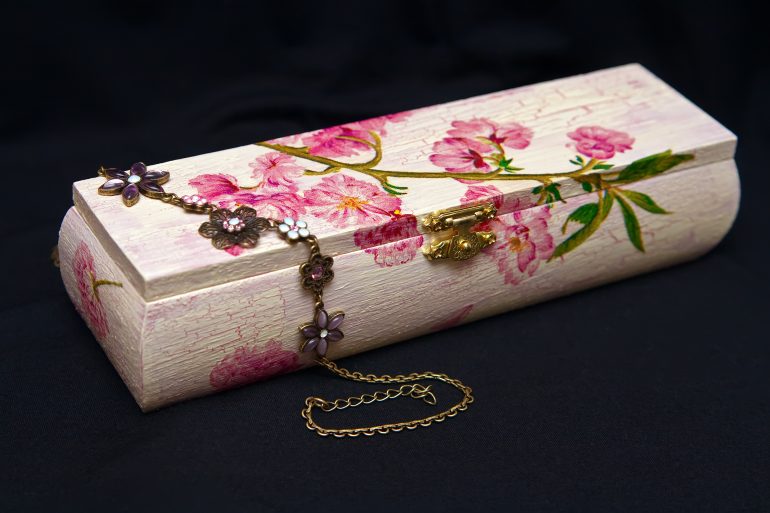The phrase “cut and paste” is most likely to evoke thoughts of a mouse and keyboard. But, for those who know their crafts, it can mean only one thing: Decoupage. This artform is all about transforming ordinary objects through the simple yet intricate application of paper cutouts. One might even say it’s the craft of decorating or painting by paper.
The term “découpage” originates from the French word “découper,” meaning “to cut out.” This artistic practice boasts a rich history, originating in East Asia and flourishing in Europe during the Enlightenment. In fact, notable historical figures such as Marie Antoinette and Lord Byron were fans.
More recently, decoupage has continued to attract both hobbyists and artists, Matisse and Picasso among them. But precisely what is the art of decoupage? What can you decoupage, and what do you need for decoupage? We’ve got the unvarnished, as well as the varnished, facts.
What is Decoupage?

Delightful decoupage (Credit: by ale_flamy via Getty Images)
At its core, decoupage is the craft of decorating objects with cutouts arranged and glued onto surfaces to create artistic designs, patterns, or pictures. It’s usually done using paper, which is cut and glued onto the surface and sealed with varnish, creating a seamless painted look. It’s usually classed as a papercraft alongside the likes of origami and papier mache, but this is not the only medium used to decoupage.
It’s thought that decoupage originated in East Asia, in regions such as China and eastern Siberia, where felt was even used to decorate certain tombs. By the 17th century, it had taken the European elite by storm, gaining further momentum in the 18th century. Over time, the cultural significance of decoupage evolved, with each era introducing new techniques and aesthetics, from the botanically accurate reproductions of Mary Delany’s ‘papermosaicks’ to Henri Matisse’s vibrant snowflowers and circus scenes.
So, that’s decoupage in a nutshell, but what do you need for decoupage? Let’s look at the materials and tools used.
Decoupage Paper

Decoupage using wallpaper (Credit: jehandmade via Getty Images)
Paper serves as the cornerstone of decoupage, with various types offering unique textures and effects. Below, the versatility of different materials used in decoupage is explored.
Speciality Decoupage Paper
- Tissue Paper: Lightweight and delicate, perfect for creating soft, translucent layers.
- Rice Paper: Known for its strength and distinctive texture, ideal for adding a touch of elegance.
- Books: Vintage book pages can add a nostalgic or literary charm to projects.
- Origami Papers: Brightly coloured and patterned, these add a playful and intricate detail.
Repurposed Papers
- Magazines: Glossy pages offer vibrant images and text for a modern look.
- Catalogues: A treasure trove of varied images and designs for diverse projects.
- Wallpaper: Durable and often richly textured, wallpaper scraps can make bold statements.
- Wrapping Paper: Festive and varied, perfect for seasonal or celebratory decorations.
- Greetings Cards: Personal and unique, adding a sentimental touch to any project.
Fabric
Aside from decoupage paper, fabric is also commonly used. Fabric pieces can add texture and depth, often used when a softer, more tactile surface is desired. It’s particularly effective for projects involving textiles, like furniture upholstery or wearable art. Incorporating fabric into decoupage involves careful preparation, such as pre-washing to prevent shrinkage.
Decoupage Tools

Decoupage tools (Credit: kicia_papuga via Getty Images)
A variety of tools are essential for decoupage, enhancing both the process and the final product:
- Scissors and Craft Knives: For precise cutting of intricate designs.
- Adhesives: Decoupage glue, Mod Podge, and other sealants are crucial for affixing and protecting the paper.
- Brushes: Various sizes for applying glue and varnish smoothly.
- Sandpaper: Prepares surfaces and smooths out any imperfections.
- Sealers and Varnishes: Provide a protective, glossy finish to the completed piece.
- Tweezers: Useful for positioning small, delicate cutouts.
Découpage Techniques

Eggs-quisite decoupage Easter eggs (Credit: Stefan Tomic via Getty Images)
Fundamental techniques in decoupage include:
- Surface Preparation: Ensuring the object is clean, dry, and smooth.
- Cutting Designs: Precision cutting of paper designs to fit the chosen object.
- Applying Adhesive: Evenly spreading glue on both the paper and the surface.
- Sealing: Applying varnish or a sealer, often several layers of them, to protect and finish the piece, enhancing its durability and shine.
What Can You Decoupage?

What a difference decoupage makes (Credit: Wild_Strawberries via Getty Images)
In terms of what can you decoupage, this includes pretty much any solid surface, be it wood, glass, cardboard, or metal. In fact, everything from walls to shoes have been decorated with this versatile craft. Some of the most popular projects include:
- Furniture: Tables, chairs, and cabinets can be transformed with paper and glue.
- Homewares: Customised picture frames, jewellery boxes, and greeting cards are popular decoupage projects.
- Everyday Objects: Items like flower pots, trays, and notebooks can be enhanced with unique designs.
To Cut a Long Story Short…

Decoupage box with intricate chain (Credit: Anita_Bonita via Getty Images)
And so, to wrap things up, we’ve answered everything from what is decoupage to what can you decoupage, touching on its rich history, necessary materials, tools, and techniques, and the boundless possibilities for application.











